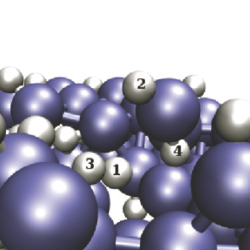Crossref Citations
This article has been cited by the following publications. This list is generated based on data provided by
Crossref.
Xu, Donghua
Wirth, Brian D.
Li, Meimei
and
Kirk, Marquis A.
2012.
Defect microstructural evolution in ion irradiated metallic nanofoils: Kinetic Monte Carlo simulation versus cluster dynamics modeling and in situ transmission electron microscopy experiments.
Applied Physics Letters,
Vol. 101,
Issue. 10,
Xu, Donghua
Wirth, Brian D.
Li, Meimei
and
Kirk, Marquis A.
2012.
Combining in situ transmission electron microscopy irradiation experiments with cluster dynamics modeling to study nanoscale defect agglomeration in structural metals.
Acta Materialia,
Vol. 60,
Issue. 10,
p.
4286.
Boozer, Allen H.
2012.
Theory of tokamak disruptions.
Physics of Plasmas,
Vol. 19,
Issue. 5,
p.
058101.
Wirth, Brian D.
Kurtz, Rick J.
and
Snead, Lance L.
2013.
Fusion materials science and technology research needs: Now and during the ITER era.
p.
1.
Xu, Donghua
Hu, Xunxiang
and
Wirth, Brian D.
2013.
A phase-cut method for multi-species kinetics: Sample application to nanoscale defect cluster evolution in alpha iron following helium ion implantation.
Applied Physics Letters,
Vol. 102,
Issue. 1,
Kolasinski, R.D.
Cowgill, D.F.
Donovan, D.C.
Shimada, M.
and
Wampler, W.R.
2013.
Mechanisms of gas precipitation in plasma-exposed tungsten.
Journal of Nuclear Materials,
Vol. 438,
Issue. ,
p.
S1019.
Zinkle, Steven J.
2013.
Challenges in Developing Materials for Fusion Technology - Past, Present and Future.
Fusion Science and Technology,
Vol. 64,
Issue. 2,
p.
65.
Barton, Nathan R.
Arsenlis, Athanasios
and
Marian, Jaime
2013.
A polycrystal plasticity model of strain localization in irradiated iron.
Journal of the Mechanics and Physics of Solids,
Vol. 61,
Issue. 2,
p.
341.
Lee, William Edward
Gilbert, Matthew
Murphy, Samuel Thomas
Grimes, Robin William
and
Green, D. J.
2013.
Opportunities for Advanced Ceramics and Composites in the Nuclear Sector.
Journal of the American Ceramic Society,
Vol. 96,
Issue. 7,
p.
2005.
Lee, William E.
Giorgi, Edoardo
Harrison, Robert
Maître, Alexandre
and
Rapaud, Olivier
2014.
Ultra‐High Temperature Ceramics.
p.
391.
Zinkle, S.J.
and
Snead, L.L.
2014.
Designing Radiation Resistance in Materials for Fusion Energy.
Annual Review of Materials Research,
Vol. 44,
Issue. 1,
p.
241.
Agarwal, S.
Trocellier, P.
Serruys, Y.
Vaubaillon, S.
and
Miro, S.
2014.
Helium mobility in advanced nuclear ceramics.
Nuclear Instruments and Methods in Physics Research Section B: Beam Interactions with Materials and Atoms,
Vol. 327,
Issue. ,
p.
117.
Trocellier, P.
Agarwal, S.
and
Miro, S.
2014.
A review on helium mobility in inorganic materials.
Journal of Nuclear Materials,
Vol. 445,
Issue. 1-3,
p.
128.
Lasa, A
Schmid, K
and
Nordlund, K
2014.
Modelling of W–Be mixed material sputtering under D irradiation.
Physica Scripta,
Vol. T159,
Issue. ,
p.
014059.
Andrievski, R.A.
2015.
The Role of Interfaces in Nanomaterials Behavior at Extremes.
Diffusion Foundations,
Vol. 5,
Issue. ,
p.
147.
Wirth, Brian D.
Hammond, K.D.
Krasheninnikov, S.I.
and
Maroudas, D.
2015.
Challenges and opportunities of modeling plasma–surface interactions in tungsten using high-performance computing.
Journal of Nuclear Materials,
Vol. 463,
Issue. ,
p.
30.
Kolasinski, R. D.
Shimada, M.
Oya, Y.
Buchenauer, D. A.
Chikada, T.
Cowgill, D. F.
Donovan, D. C.
Friddle, R. W.
Michibayashi, K.
and
Sato, M.
2015.
A multi-technique analysis of deuterium trapping and near-surface precipitate growth in plasma-exposed tungsten.
Journal of Applied Physics,
Vol. 118,
Issue. 7,
Knaster, J.
Moeslang, A.
and
Muroga, T.
2016.
Materials research for fusion.
Nature Physics,
Vol. 12,
Issue. 5,
p.
424.
Luce, F. P.
Oliviero, E.
Azevedo, G. de M.
Baptista, D. L.
Zawislak, F. C.
and
Fichtner, P. F. P.
2016.
In-situ transmission electron microscopy growth of nanoparticles under extreme conditions.
Journal of Applied Physics,
Vol. 119,
Issue. 3,
Hu, Xunxiang
Koyanagi, Takaaki
Fukuda, Makoto
Kumar, N.A.P. Kiran
Snead, Lance L.
Wirth, Brian D.
and
Katoh, Yutai
2016.
Irradiation hardening of pure tungsten exposed to neutron irradiation.
Journal of Nuclear Materials,
Vol. 480,
Issue. ,
p.
235.



